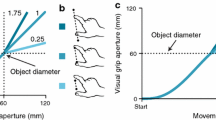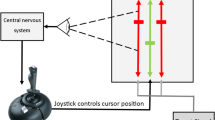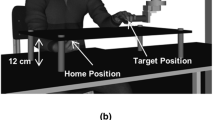Abstract
Vision of the hand during reaching provides dynamic feedback that can be used to control movement. We investigated the relative contributions of feedback about the direction and distance of the hand relative to a target. Subjects made pointing movements in a 3-D virtual environment, in which a small sphere provided dynamic visual feedback about the position of their unseen fingertip. On a subset of trials, the position of the virtual fingertip was smoothly shifted by 2 cm during movement, either (1) in the direction of movement, which would require adjustments to the distance moved, or (2) orthogonal to the direction of movement, which would require adjustments to the direction moved. Despite not noticing the perturbations, subjects adjusted their movements to compensate for both types of visual shifts. Corrective responses to direction perturbations were observed within 117 ms, and response latencies were invariant to movement speed and perturbation onset time. Initial corrections to distance perturbations were smaller and appeared after longer delays of 130–200 ms, and both the speed and magnitude of responses were reduced for early onset perturbations. Simulations of a feedback control model that optimally integrates visual information over time show that the results can be explained by differences in the sensory noise levels in the visual dimensions relevant for direction and distance control.









Similar content being viewed by others
References
Brenner E, Smeets JBJ (1997) Fast responses of the human hand to changes in target position. J Motor Behav 29(4):297–310
Burbeck CA (1987) Position and spatial frequency in large-scale localization judgments. Vision Res 27:417–428
Burbeck CA, Yap YL (1990) Two mechanisms for localization? Evidence for separation-dependent and separation-independent processing of position information. Vision Res 30:739–750
Chieffi S, Allport DA (1997) Independent coding of target distance and direction in visuo-spatial working memory. Psych Res 60(4):244–50
De Bruyn B, Orban GA (1988) Human velocity and direction discrimination measured with dot patterns. Vision Res 28:1323–1336
Gordon J, Ghilardi MF, Ghez C (1994) Accuracy of planar reaching movements. I. Independence of direction and extent variability. Exp Brain Res 99(1):97–111
Hoff B, Arbib MA (1993) Models of trajectory formation and temporal interaction of reach and grasp. J Motor Behav 25:175–192
Krakauer JW, Pine ZM, Ghilardi MF, Ghez C (2000) Learning of visuomotor transformations for vectorial planning of reaching trajectories. J Neurosci 20(23):8916–24
Levi DM, Klein SA, Yap YL (1988) Weber’s law for position: unconfounding the role of separation and eccentricity. Vision Res 28:597–603
Mateef S, Dimitrov G, Genova B, Likova L, Stefanova M, Hohnsbein J (2000) The discrimination of abrupt changes in speed and direction of visual motion. Vision Res 40:409–416
Messier J, Kalaska JF (1999) Comparison of variability of initial kinematics and endpoints of reaching movements. Exp Brain Res 125(2):139–52
Orban GA, Van Calenbergh F, De Bruyn B, Maes H (1985) Velocity discrimination in central and peripheral vision. J Opt Soc Am A 11:1836–1847
Pelisson D, Prablanc C, Goodale MA, Jeannerod M (1986) Visual control of reaching movements without vision of the limb. II. Evidence of fast unconscious processes correcting the trajectory of the hand to the final position of a double-step stimulus. Exp Brain Res 62(2):303–11
Prablanc C, Martin O (1992) Automatic control during hand reaching at undetected two-dimensional target displacements. J Neurophysiol 67(2):455–69
Sainburg RL, Lateiner JE, Latash ML, Bagesteiro LB (2003) Effects of altering initial position on movement direction and extent. J Neurophysiol 89(1):401-415
Saunders JA, Knill DC (2003) Humans use continuous visual feedback from the hand to control fast reaching movements. Exp Brain Res 152(3):341–352
Saunders JA, Knill DC (2004) Visual feedback control of hand movements. J Neurosci 24(13):3223–3234
Sarlegna F, Blouin J, Bresciani JP, Bourdin C, Vercher JL, Gauthier GM (2003) Target and hand position information in the online control of goal-directed arm movements. Exp Brain Res 151:524–535
Toet A, Konederink JJ (1988) Different spatial displacement discrimination thresholds for Gabor patches. Vision Res 28:133–143
Turrell Y, Bard C, Fleury M, Teasdale N, Martin O (1998) Corrective loops involved in fast aiming movements: effect of task and environment. Exp Brain Res 120(1):41–51
Werkhoven P, Snippe HP, Toet A (1992) Visual processing of optic acceleration. Vision Res 32:2313–2329
Whitaker K, Latham K (1997) Disentangling the role of spatial scale, separation and eccentricity in Weber’s law for position. Vision Res 37:515–524
Author information
Authors and Affiliations
Corresponding author
Rights and permissions
About this article
Cite this article
Saunders, J.A., Knill, D.C. Humans use continuous visual feedback from the hand to control both the direction and distance of pointing movements. Exp Brain Res 162, 458–473 (2005). https://doi.org/10.1007/s00221-004-2064-1
Received:
Accepted:
Published:
Issue Date:
DOI: https://doi.org/10.1007/s00221-004-2064-1




